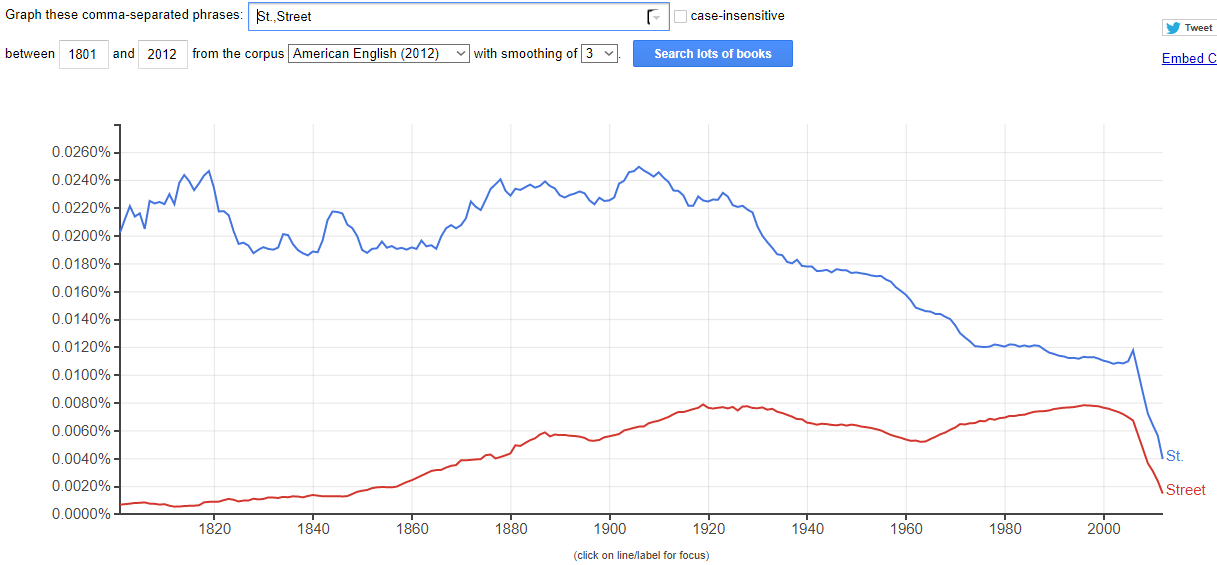Note I'm not intending this to be the answer, but rather a summary of my research that will hopefully help you along.
My line of thinking towards a possible solution went along these lines:
- Trends that have existed in published works;
- Origin of the abbreviation "St.";
- Possible influences on this (though it may be quite difficult to choose a definitive reason).
Trends
I think you're right in that there's been a change. However, I'm not aware of any tools that would allow us to explore this. Regarding the trends, there has been a change where the popularity of "Street" actually increases in the late 19th century but this is not a very good comparison as alternative uses of the abbreviation (for 'Saint' and 'Strait') aren't quantified. Nevertheless, some trends do emerge:

Now, this is not newspapers only (actually be only books though some journals also make it in there, I believe) but the general trends could be similar.
Origin of "St."
I was unable to find a source for the origin of the abbreviation "St." for "Street" but it is likely to be older than that turn of the century (maybe?). I'd recommend a query on English:SE for this; their only question thus far on "St."/"Street" is not very useful for this.
Possible Influences
Editorial Standards
The next thing I thought about were editorial standards. It may have been the case (unproven hypothesis coming up...) that as newspapers have conglomerated, editorial standards of one "main" newspaper have been made to apply in their subsidiary ones as well. (Another unproven hypothesis coming up...) Perhaps some minor Californian newspapers got taken over by a bigger one that enforced its style guide for the use of the abbreviated form?
An academic style guide example from DePaul University mentions "St."/"Street":
addresses
Abbreviate Ave., St. and Blvd., when used with a numbered address: 2400 N. Sheffield Ave. All other designations, such as Drive, Road and Circle, are spelled out. Spell out and capitalize when naming the street with no number: Fullerton Avenue, Jackson Boulevard. Lowercase the words street, avenue, etc., when used alone or with more than one street name: the corner of Fullerton and Sheffield avenues.
The original publishing year for this guide isn't noted, but it is likely to be relatively recent if also not frequently edited. I'm more aware of the British journals' style guide myself.
Postal Standards
However, this led me down a path to why "St."/"Street" would be used in street names at all. Wikipedia lists street suffixes based on a USPS standard, "Publication 28 - Postal Addressing Standards". The present form for this is from May 2015, and this mandates the use of abbreviated street suffixes (211).
A standardized address is one that is fully spelled out, abbreviated by using
the Postal Service standard abbreviations (shown in this publication) or as
shown in the current Postal Service ZIP+4 file.
This is too late to be relevant to the changes you describe. I didn't find many older references to such a standard, including specific searches for the Post Office Department's address standardizations came up empty. Yet, I would suspect they had something—others may have a better idea of where to look.
That said, general address standards (and address standardization as a process) are relatively recent with Coetzee saying that in the US, this process started in 1996 with the 'United States Thoroughfare, Landmark, and Postal Address Data Standard' by the US Federal Geographic Data Committee. I'm not sure this is right, but I also didn't find an older version of the "Postal Addressing Standards" to disprove this claim.
